Will Viking Fjord Be Sold in America Again?
When many of u.s.a. think about the Viking age, nosotros oftentimes have images of men with long hair and an epic beard, holding a long sword or a giant Dane ax, while running across a field into a legendary battle. Still, zero can exist further from the truth than merely to think most the Vikings as people who were out for bloodthirst.
The Viking historic period was much more than just violence and disharmonize, affairs and peaceful trade amid tribes and Kingdoms were as well a big role of the activities in and outside of Scandinavia.
It is also important to know that the Vikings knew almost the British Isles, and it was non something that was discovered past some rumor, or for that fact, by Ragnar Lothbrok every bit it was depicted in the evidence Vikings from the history channel. The people in Scandinavia were very much enlightened of the state to the due west.
Merchandise was also not something that was new to the Nordic people, not just had they traded with each other since the bronze age, but they had likewise traded with people further away, such as on the British Isles.
I know that to a lot of you, this is a common fact, and I might besides explain what the color in the sky is… but the media, and even billion-dollar studios, that should have a big enough budget to hire an good in the Viking age, keep misrepresenting the Vikings.
I also know that there are some of you who will question my use of the word Viking, and wonders why I characterization all in Scandinavia every bit such, but for that, y'all tin check out my other video, called "what does the give-and-take Viking mean?", where I address this consequence since I don't want to repeat information technology again.
To simplify I accept carve up this commodity into three groups, the Danes, the Norwegians, and the Swedes. However, y'all should keep in mind that society consisted of multiple tribes and Kingdoms in the Viking historic period.
Prior to the Viking age trading took place at temporary markets or in very small villages along the coast in Scandinavia. And it is not until we enter the Viking historic period, that we start to see the first proper trading towns across Scandinavia.
Merchandise became more than and more of import but also easier to conduct, for case, the development of the Viking transport had a profound role in the expansion of merchandise. It slowly started to go a crucial part of the local economic system in Scandinavia, and it was therefore in the interest of the Kings to have towns that conducted this lucrative merchandise within their Kingdom, and they were prepared to fight for it.
The Vikings would eventually become a part of a huge trade network that spanned from Republic of iceland to Constantinople, and from Republic of ireland to the most remote parts of what today is Russia.
The beginning Viking trade towns in Scandinavia were probably established past either Jarls or Royals who were the people from the upper form, and therefore had a lot of wealth and influence. There was significant demand for luxury products by the elite, and products such as wine and Frankish glass, and silk from Asia were hard to come past at the showtime of the 8th century.
The first sign of what seems to be a permanent market in Scandinavia has been found in the city of Ribe which is located in the western parts of Denmark.
The Viking Trade Boondocks Ribe
At the beginning of the 8th century (705 CE), it was either a Rex or a very powerful Jarl who gave permission to some of the local merchants to set upward their tents and small wooden houses on a field right next to the town of Ribe in Denmark.
Ribe which already was a prominent town, would in the following decades get a well-known Viking merchandise town among many of the traveling merchants.
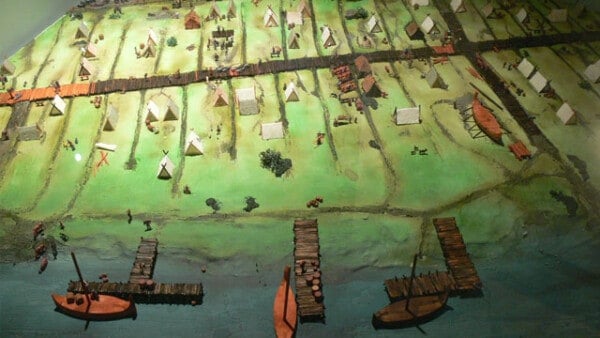
The field was 200 meters long and 65 meters wide, and it was placed just side by side to the Ribe River. Which made it a perfect place to conduct trade since the merchants could canvas their ships correct up side by side to the market.
The field was divided into pocket-size sections of 6-8 meters broad plots of land on either side, and they were separated by either pocket-sized ditches or paths. The main roads were made from wooden planks, which made it ideal to transport heavy goods with horse-drawn vehicles.
Towns such as Ribe were not a place where ordinary people lived, they lived their lives out in the countryside in pocket-sized villages on their farms. The people who lived in the towns were either the upper class which was called Jarls, or the merchants and craftsmen that made their livelihood from either producing or trading goods.
Most of the products that were produced in trading towns such as Ribe was sold as consign, while the products that were brought to Ribe past foreign merchants were purchased by the local merchants and sold in the nearby villages, or past traveling from subcontract to farm.
A place that had a lot of trade like Ribe would, of course, attract unwanted visitors in the form of Viking raids. It was therefore very important that the King or the local magnate could provide the necessary protection, so the traveling merchants and craftsmen would feel safe enough to acquit their business in Ribe.
However, this was probably non something that was free, and there was probably a sales tax for those who wished to trade in Ribe, and the Male monarch e'er got his cutting of the cake.
As I have oft said, the past is not behind us, it is beneath us. Our soil is total of our history and the memories of our ancestors. And I am very happy that Ribe has gotten a lot of attending in the last few decades from the archeologists, and that the regime has earmarked a lot of resource to assistance conduct more excavations in Ribe.
I believe that in that location are many more than great finds to be discovered in Ribe, and the future has many more treasures from the past hidden from us, just waiting to be discovered.
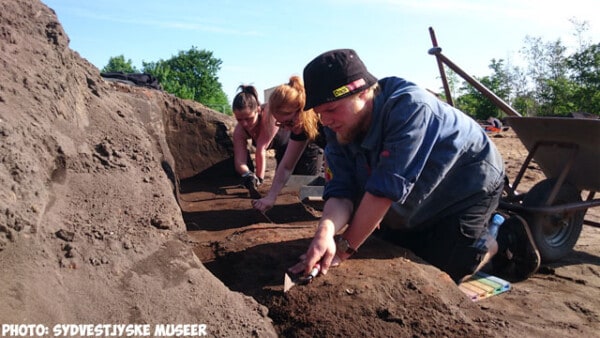
The Viking Merchandise Boondocks Hedeby
The ancient boondocks of Dorestad which today is located in the Netherlands was an of import trading town, before and at the first of the Viking historic period. Dorestad was founded in the seventh century, and information technology might have been established where the former Roman fortress of Levefanum was built.
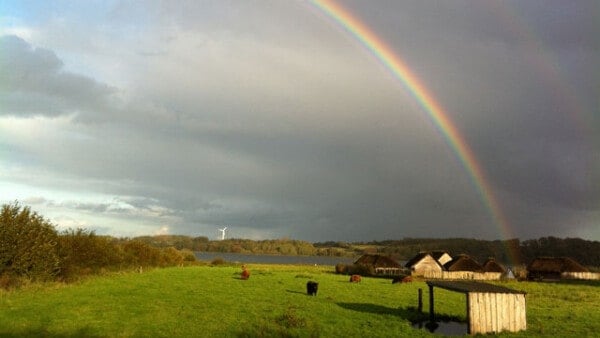
Yet, at the outset of the 9th century, the merchants began to stay abroad from Dorestad due to the many Viking raids, and Dorestad slowly lost its dominance in the trade network. Instead, the small town called Hedeby in Denmark started to become the new Viking trade hub in the north.
Hedeby (Old Norse Heiðabýr, German language Haithabu) was the southernmost town in Scandinavia during the Viking Age, and today it is located to the s of the city Schleswig in Germany.
Hedeby is located next to the river Schlei (Danish: Slien), which has direct access to the sea, and it made it easy for visitors to travel to and from Hedeby by ship. Placing the trade towns further into the land, instead of next to the declension, was a strategic move because in that way it was possible to observe if information technology was a friendly or hostile transport that entered the river.
Further south is the river Eider (Ejderen) where they had easy access to the North Sea. This was a shortcut through the peninsula of Jutland, and it would save the travelers the hassle of sailing around the entire peninsula of Jutland, this probably came at a fee to the local King.
The river Eider too marked the sometime Danish border, which separated the Danes, the Saxons, and the Slavic from each other. To the west beyond the marshlands were the border to the Friesians. Hedeby was continued to many other important Danish towns past the army road (Danish: Hærvejen), also known equally the ox route. This was a 500 km long road that stretched from the Jutland peninsula in the north to the border in the southward.
The boondocks was known under many different names in the Viking age, sources such every bit poems and runestones as well refer to Hedeby as, Sliesthorp, Sliaswich, Slesvic, æt Hæthum, and Haitha past. Another reason why Hedeby became an of import Viking trade town, was probably also due to the fact that the Danish King named Godfrey used his ground forces to attack and destroyed the trading town of Reric in Northern Germany in 808.
The lives of the merchants and craftsmen were spared by the Danish King, if they agreed to move to Hedeby, and conduct their business from in that location instead.
Godfrey so ordered fortifications to be congenital around Hedeby to protect the town from unwanted visitors. However, it is unclear if he ordered new fortifications to exist built, or if he simply repaired the ancient border walls known as Dannevirke and Kovirke that were located near Hedeby.
Dannevirke has been expanded and repaired multiple times, and 2 people who probably had a huge bear on on these fortifications around Hedeby were Queen Thyra (Besides known equally: Thorvi or Thyre), and her son Harald "Bluetooth" Gormsson.
How Dannevirke was built
We have an old Danish folklore hither in Denmark most how Dannevirke was built, this saga has been told and retold for more than one yard years to our friends and family. Quondam in the middle of the 9 century, Otto the Slap-up, who was the King of East Francia, wanted to go the Danes under his thumb so he could collect taxes from them.
So Otto the Not bad traveled to Jelling where King Gorm the old and his wife Queen Thyra lived. Upon arriving he saw the beautiful Thyra and he immediately fell all in love with her. So King Otto told Rex Gorm that he wanted all the aureate in his Kingdom, including his wife Thyra, and if he refused to follow his command, he will take it by force anyway.

Rex Gorm who was stupid and lazy sat on his throne and looked at him while he was picking his nose with an open mouth and bare stare. Wondering what to say, he only manages to mumble a bit for himself considering he was too stupid to think of an answer.
Only then the smart and beautiful Queen Thyra stepped forward and bowed to Male monarch Otto and said, of course, we will do as you lot please. You can have all the gold in our Kingdom and of course, you shall accept me as well, we are later all only a small Kingdom and you take such a big and mighty empire.
My King if y'all only give me one year, I will personally together with my close guards travel effectually the whole Kingdom of Kingdom of denmark and collect all our gilded and silverish for you. When you come back here next year on the same engagement, all the gold and silver will be packed and ready for you to transport it dorsum with you, and of course, I volition travel with yous back to Due east Francia and become your Queen.
Rex Otto scratched himself on the back of the head, thought virtually it for a minute, and said, aye that sounds similar a good idea, and I don't fifty-fifty have to do all the traveling effectually your Kingdom myself, okay Thyra, I will be dorsum in exactly ane year.

The next day, Queen Thyra began to travel around the Kingdom and nerveless all the silver and gold, only instead of collecting it for King Otto the Corking, she used information technology to build a wall called Dannevirke, which would part every bit a defensive fortification against the enemies from the south.
Ane year later King Otto returned to Denmark, but he was stopped in his tracks by a massive wall, that stretched as far as the eyes could see. On pinnacle of the wall, Queen Thyra and all her warriors stood and looked down, laughing and pointing at them, while making chicken noises at Rex Otto and his men.
During the 11th century, the h2o in the river Schlei began to rise, and it is estimated that it rose by 120 cm. Which made it more than difficult to behave trade from Hedeby, and the merchandise slowly began to motility to other towns.
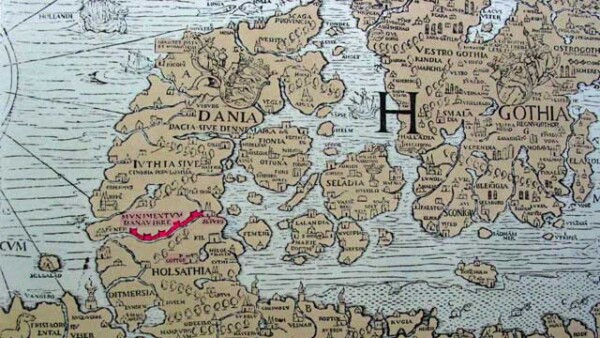
Other Viking trading towns in Kingdom of denmark
While Ribe and Hedeby were very important Norse trading towns in Denmark during the Viking historic period, at that place were also other towns that are worth mentioning. Trading towns such every bit Odense on the island of Funen (Danish: Fyn), and Roskilde on the island of Zealand (Danish: Sjælland).
The town Århus (Aros) in northern Jutland was too very important, the boondocks was founded close to the turn of the 9th century (890-899 CE), it is an interesting town that I call back we will hear much more than about in the future.
To the east on the fertile lands of Halland, Blekinge, and Skåne, the Danes had a trading boondocks called Lund. Today these parts are no longer under Danish control, the areas were lost to the Swedes many centuries later on the Viking age. This is non a list of all the trading towns in Kingdom of denmark during the Viking Age, but these are some of the near of import ones.
Export from Denmark during the Viking historic period
If you want to trade with foreign merchants, y'all need something to trade with. The Danes sold products such as amber, dried fish, ceramic, slaves, and textiles, but also resold items to people in the due south from the merchants that came from Norway.
The Viking Trade Town Birka in Sweden
For the Swedes, information technology was Birka that was the biggest and most important trade town during the Viking age. Birka was just like Hedeby located further inland, and the town was connected with rivers to the Baltic Bounding main to the east and south, if y'all were to follow the minor rivers to the northward from Birka, it would pb yous to Uppsala.
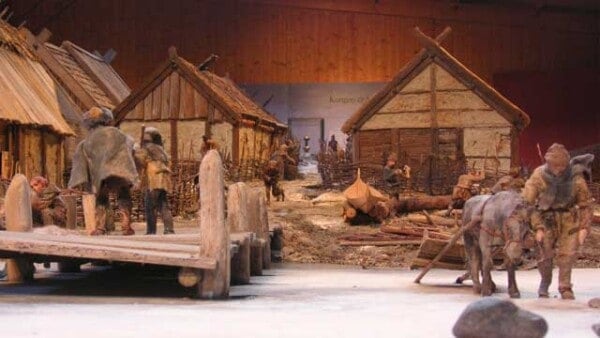
This aboriginal Viking town was located on the island of Björkö in Lake Mälaren, which is about 30 Km west from the upper-case letter of Sweden. For good measure it should be said that Stockholm did non exist in the Viking age, information technology was founded many centuries later in 1252.
Mälaren is a huge lake and it spans 120 kilometers from the east to the w, and at its greatest depth, it is 64 meters deep. The area around Mälaren was inhabited past a lot of Swedes, and there was a good reason for that. The area is rich, very rich in natural resources, and the export of materials such every bit iron and fur generated an enormous corporeality of wealth for the locals.
Birka was well protected, merely like Hedeby in Kingdom of denmark, and it had a defensive fortification around the town, that was guarded by local warriors. This town is non as old as Hedeby, information technology was founded sometime in the middle of the 8th century nearly 50 years later, but there accept lived people here in this area for hundreds of years.
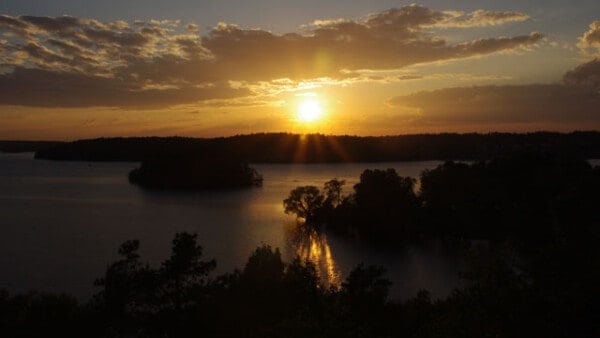
While Birka is surrounded by many beautiful rivers today, the landscape was non quite the same during the Viking age. For instance, the ground level was in full general much lower back then, and the rivers around Birka is believed to accept been almost 5 meters lower than what they are today.
Other Viking trading towns in Sweden
Some of the other important trading towns in Sweden that are worth mentioning are, Sigtuna and Södertälje, which are also located in the eastern part of Sweden. We also have, Skara and Lödöse, which is located in the western office of Sweden, and Uppåkra to the southward. Köpingsvik on the isle of Öland, and Visby on the island of Gotland should also be mentioned, Gotland was an island that saw a lot of merchandise during and after the Viking age, and it is in full general an area of significant historical importance, and worth a visit.
Export from Sweden during the Viking historic period
The Swedes typically sold amber, beeswax, honey, atomic number 26, slaves, and furs. Falcons were also highly sought after by foreign merchants, a falcon was quite an expensive bird, and it was one of those luxury products that the upper grade was interested in.
The Viking Trade Town Kaupang in Norway
Side by side, is the state of Kingdom of norway, here there was a town called Kaupang in the Viking age, and that was located right adjacent to the inlet called Viksfjorden (in the Larvik municipality), which was and still is a dandy place for fishing.
This location is i of the about fertile areas in Kingdom of norway, and it was an expanse and a boondocks that was highly sought-after. The ownership of this state switched dorsum and along between rulers, throughout the Viking historic period.
Kaupang was the first Norwegian trading town that nosotros know of, and it was founded around 780 CE, which was about 20-xxx years before the Danish trading town Hedeby. There is no doubt that this identify used to exist a marketplace, non only have there been found many objects that indicate this, the name itself (Kaupangr) literally means marketplace-identify or trading place in former Norse.
Just like Birka was of import to the Swedes, and Hedeby was important to the Danes, this town was of great significance to the Norwegians. Merchants and craftsmen would travel here from all over Kingdom of norway to sell their products.
The founders of Kaupang could almost not have picked a improve spot for the boondocks, and the location is near perfect. Information technology was easy to travel south to Jutland where there were many Danish trading towns, and the British Isles was around the declension to the w.
Other Viking trading towns in Norway
In the 10th century (997 CE), Olaf Tryggvason founded the trading town of Trondheim in northern Norway, or at least it was him according to the rumors. The town was originally called Nidaros (Old Norse: Niðaróss) "Mouth of the river Nid", but some people referred to the boondocks equally Kaupang (Old Norse: Kaupangr í Þróndheimi), which meant trading place or marketplace in Trondheim.
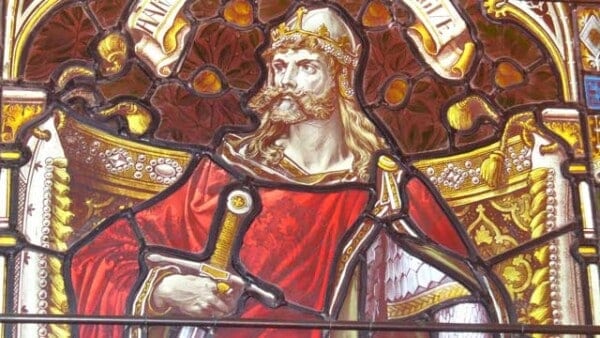
In 1049 CE the boondocks Oslo was founded by Harald Hardrada, however, at that place accept in contempo years been found evidence to advise, that the city could exist much older.
I recollect the town of Tønsberg should also exist mentioned since it is the oldest town in Norway according to the sagas. The boondocks was founded onetime in the 9th century by Rex Harald Fairhair. All the same, how much trade was conducted from hither, and if it even tin can exist chosen a trade town is questionable.
Export from Norway during the Viking age
Kingdom of norway is a country with many natural resource, and some of them are more valuable than others. I of these resources was stones, for instance, millstones (In Danish: Kværnsten). Millstones were in high demand in many parts of northern Europe because they were used for grinding wheat and other types of grain.
Soapstones (in Danish: Klæbersten) were also sought afterward, these stones were used to make objects such every bit cauldrons, drinking vessels, bowls, and many other useful items. The small soapstones were also useful, and they were used on the line-fishing nets, merely likewise on the loom.
Grinding stones (in Danish: Slibesten) were also very pop, they were used for sharpening weapons, such as axes, swords, and spears.
One of the most valuable resources from Norway during the Viking age was iron. Iron was equally y'all can imagine in very loftier demand, not but was it used to brand weapons for war, such equally spears and axes but it was besides used to make locks for their houses.
Other resources that were traded from Kingdom of norway, were Falcons, stale fish, woolen, feathers, walrus ivory, and animate being hides. Agricultural products were also normally traded with foreign merchants.
Consign from Greenland during the Viking age
In 982 CE Erik the red (In Norwegian: Eirik Raude), too called Erik Torvaldson (Old Norse: Eiríkur rauði Þorvaldsson) discovered new lands to the due west. The country had an inviting fjord landscape, and lush green valleys, as far as he could encounter. He chosen it Greenland, and as you lot can imagine he probably came here during the summertime months.
The people who eventually would settle here on Greenland began to sail s with products such as walrus ivory, animal hide, polar bear fur, falcons, and feathers.
Export from the Faroe Islands during the Viking age
Afterwards the first settlement was established on the Faroe islands in 825 CE by Grímur Kambans, they began to sail south again to the British Isles, with products such as walrus ivory, brute hides, and most likely also dried fish.
Export from Iceland during the Viking historic period
After Iceland was settled in 874 CE, products such equally walrus ivory, falcons, furs, and woolens. Iceland was not actually a destination for trade, so the merchants sailed their products s, nearly probable to trade towns on the British Isles.
Products imported to Scandinavia during the Viking age
The people in Scandinavia traded with people from all over Europe. The merchants either sailed northward to one of the Scandinavian trading towns, or they sailed south to visit one of theirs.
The nordic people were interested in foreign products such equally grain, herbs, ceramic, lignite (Also called: chocolate-brown coal), slaves, fruit, nuts, glass, and drinking glass beads.
Some products that were considered very luxurious were, wine, spices, silver, tin can, salt stones, sea salt, steel, gemstones, and jewelry fabricated from gold or silver. The very wealthy people in Scandinavia imported silk from the Mediterranean and the far east.
The towns in the Viking trading network:
City fortifications (C)
Garrisons: (G)
Very important trade hub: (I)
List of Viking trading towns in Scandinavia (Non all are listed):
Kingdom of denmark
Hedeby (Old Norse: Heiðabýr) (I, C, G)
Ribe (Quondam Norse: Riba) (I, G)
Århus (One-time Norse: Aros) (I, C, One thousand)
Lund (I, C, Thou)
Odense (G)
Roskilde (G)
Norway
Kaupang (Sometime Norse: Kaupangr) (I, One thousand)
Trondheim (Old Norse: kaupangr í Þróndheimi)
Oslo (I)
Sweden
Birka (I, C, G)
Västergarn (I, One thousand)
Sigtuna (G)
Södertälje
Skara
Lödöse
Uppåkra
Visby (I, C, Chiliad)
Viking trade routes / Viking towns outside of Scandinavia
With the Viking expansion into literally all directions from Scandinavia, new towns and trade hubs were slowly established on the mainland and islands scattered throughout Europe. Since the Merchants was worried about being attacked by Viking raiders, and losing all their valuable possessions they would often travel in groups, and sometimes with hired guards. This meant they would not be an piece of cake target, and the raiders would need a sure amount of strength to rob them of their goods.
It was non only the people who were merchants every bit a profession that joined these trade voyages. Local craftsmen that wanted to take a hazard to make some actress argent coins, would occasionally join the crew and set sheet to foreign lands. If these local craftsmen had to pay to join the voyages, or if the merchants just found it useful to have an extra pair of hands to row the boat, is something we do not know for certain.
Diplomacy between Kings and Queens across the borders was another mode to ensure safe passage for the merchants. It as well was in everyone's best interest that the trade between towns, tribes, and countries would exist every bit smooth equally possible. The influential and powerful people who made this possible would, of course, take their fair share in the form of taxes from the appurtenances that were sold in the markets.
York was called Jorvik past the Vikings
Bharat has often been described equally the crown jewel of Britain when India was under British dominion, and what India was to United kingdom, Britain definitely was to the Vikings. The human relationship between the Vikings from Scandinavia and the people on the British Isles began with raiding, pillaging, and trading.
Notwithstanding, while the journeys west probably were a great way to fill the pockets with bloodstained silver from the poor victims, the potential on the British Isles was far greater than sailing back and forth just to behave raids.
In 865 CE the ii brothers Halfdan and Ivar the Boneless led a huge army of Danish Vikings, called the Great Infidel Army towards the British Isles. The army disembarked in East Anglia and headed northward. Afterwards one year of raiding the locals, the Danes arrived at the town of York in 866 CE. The Vikings defeated the Anglo-Saxons and the boondocks cruel under the command of the Danish crown.
York or Jorvic as the boondocks was called by the Vikings, would slowly see a steady menstruum of migration flooding in from Kingdom of denmark, and turning the town into i of their near of import trading towns away.
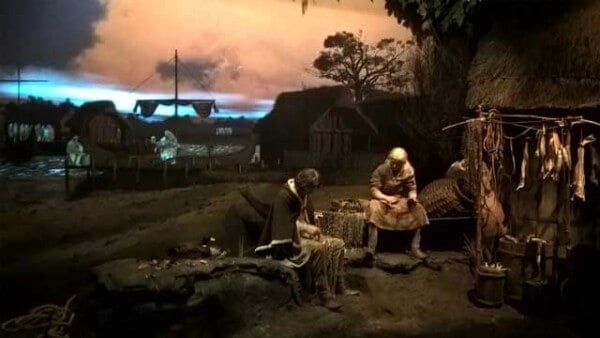
York would a few decades later become a part of Danelaw (Also known as: Danelagh) which was an enormous expanse that the Danes had conquered from the Anglo-Saxons. Information technology was called Danelaw, because the Brits that lived in this area, were nether Danish constabulary.
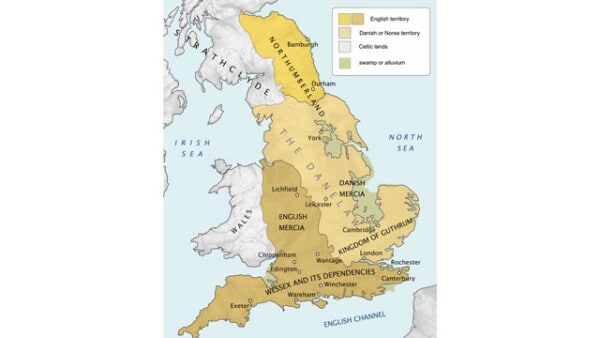
The Viking town Dublin
Some other important trading boondocks for the Vikings was Dublin, which was founded in 841 CE. Here the trade was mainly focused around slavery, but modern excavations also seem to indicate that shipbuilding, and perchance with the assistance from slavery were conducted in the area.
Trading towns in eastern Europe
Among the Scandinavians, it was mainly the Swedes that conducted trade in eastern Europe. The Swedes, or Rus as they were called by the Slavic tribes to the e, had multiple trading towns that were important to them.
The boondocks called Staraya Ladoga (In Russian: Старая Ладога) located on the Volkhov River almost Lake Ladoga, was 1 of the first trade hubs on the journey to the east.
A bit to the s along the river, they would arrive at Novgorod (Quondam Norse: Holmgaard) (In Russian: Новгород), and further down to the southward were another important trading town, which was chosen Kiev/Kyiv (Erstwhile Norse: Kaenugaard).
If they Connected the journey from Kyiv and south along the Volga river, they would eventually arrive at the black body of water, and from here they could keep sailing south until they arrived at Constantinople.
Constantinople, or as it was known to the Scandinavians, Miklagård (Quondam Norse: Miklagarðr) which means the big metropolis, was an of import strange trading boondocks for the Scandinavians. It was here they had access to silk and other exotic trade goods from Asia.
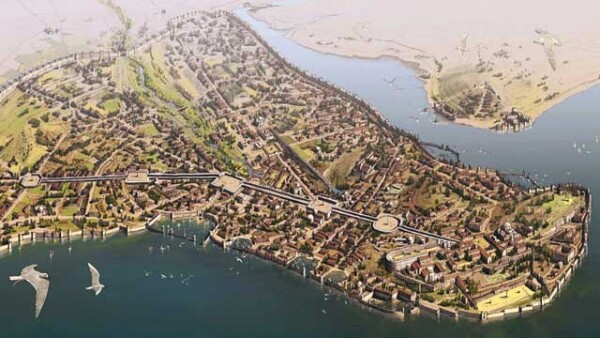
To the eastward from Staraya Ladoga and along the river Volga, was were the Rus traded with the Bulgars on their mode s, something that the Arabic diplomat Ahmad Ibn Fadlan (In Arabic: أحمد بن فضلان بن العباس بن راشد بن حماد) from Baghdad (In Arabic: بغداد) wrote about. This was also the route they sailed when they wanted to travel to the Caspian Sea (In Russian: Каспийское море). Again, these are not all the trading towns that the Norse visited, simply they are some of the more important ones.
Strange trading towns: (Non all are listed)
City fortifications (C)
Garrisons: (G)
Very important trade hub: (I)
York (Northumbria, England) (I, C, M)
Hamwic (Wessex, England)
Dublin (Ireland) (I, C, G)
Dorestad (Netherlands) (I)
Rouen (France)
Nantes (France)
Arles (France)
Truso (Poland)
Wolin (Poland)
Staraja ladoga (Russian federation) (I, C, G)
Novgorod (Russia)
Kiev (Ukraine) (I)
Constantinople (Istanbul, Turkey) (I, C, One thousand)
Rome (Italy)
Pisa (Italy)
Lissabon (Portogal)
La Coruña (Spain)
Sevilla (Espana)
Sources
Kim Hjardat – Vikingernes liv og færden 2013
Else Roesdahl – Vikingernes Verden 1996
Trade in the Viking age – Natmus
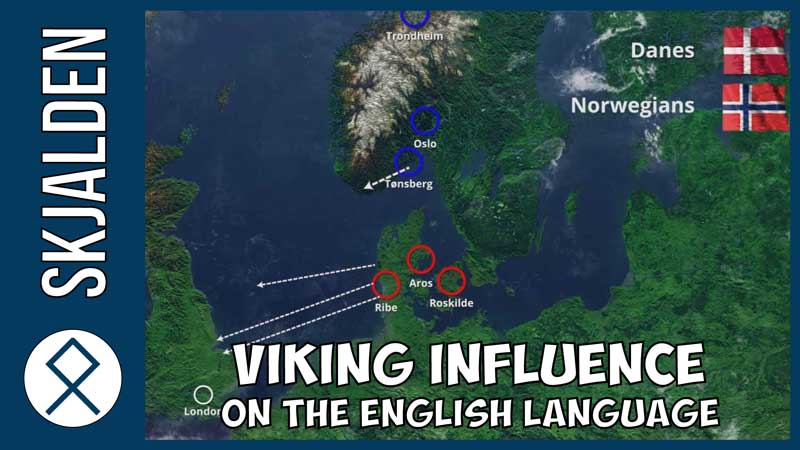
Source: https://skjalden.com/where-did-the-vikings-trade/
0 Response to "Will Viking Fjord Be Sold in America Again?"
Post a Comment